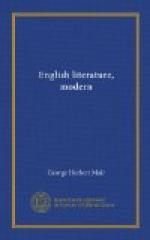That, however, was not quite how the thing worked in actual fact. At the heels of the “Character” came the periodical essay of Addison and Steele. Their interest in contemporary types was of the same quality as Earle’s or Hall’s, but they went a different way to work. Where these compressed and cultivated a style which was staccato and epigrammatic, huddling all the traits of their subject in short sharp sentences that follow each other with all the brevity and curtness of items in a prescription, Addison and Steele observed a more artistic plan. They made, as it were, the prescription up, adding one ingredient after another slowly as the mixture dissolved. You are introduced to Sir Roger de Coverley, and to a number of other typical people, and then in a series of essays which if they were disengaged from their setting would be to all intents a novel and a fine one, you are made aware one by one of different traits in his character and those of his friends, each trait generally enshrined in an incident which illustrates it; you get to know them, that is, gradually, as you would in real life, and not all in a breath, in a series of compressed statements, as is the way of the character writers. With the Coverley essays in the Spectator, the novel in one of its forms—that in which an invisible and all knowing narrator tells a story in which some one else whose character he lays bare for us is the hero—is as good as achieved.
Another manner of fiction—the autobiographical—had already been invented. It grew directly out of the public interest in autobiography, and particularly in the tales of their voyages which the discoverers wrote and published on their return from their adventures. Its establishment in literature was the work of two authors, Bunyan and Defoe. The books of Bunyan, whether they are told in the first person or no, are and were meant to be autobiographical; their interest is a subjective interest. Here is a man who endeavours to interest you, not in the character of some other person he has imagined or observed, but in himself. His treatment of it is characteristic of the awakening talent for fiction of his time. The Pilgrim’s Progress is begun as an allegory, and so continues for a little space till the story takes hold of the author. When it does, whether he knew it or not, allegory goes to the winds. But the autobiographical




